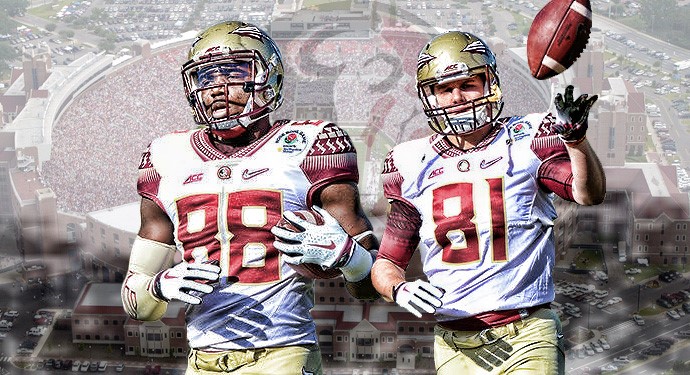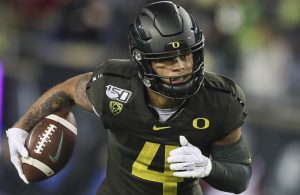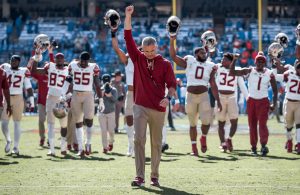- Sunday Seminole Summary: FSU Football Adds Pair of WR Transfers
- Sunday Seminole Summary: FSU Football Exits ESD With Top-15 Class
- Sunday Seminole Summary: FSU Soccer Tops BYU for Third National Championship
- Sunday Seminole Summary: FSU Soccer Advances to National Championship Match
- Seminole Sunday Summary: FSU Soccer Heads Back to College Cup
- Seminole Sunday Summary: FSU Soccer Reaches Sweet 16; Football Tops Boston College
- Seminole Sunday Summary: FSU Soccer Wins ACC, Advances to Second Round of NCAA Tournament; FSU Football Rallies Past Miami
- Seminole Sunday Summary: FSU Soccer Tops Wake on OT to Advance to ACC Final
- Seminole Sunday Summary: FSU Football Crushes UMass for Third Straight Win
- Seminole Sunday Summary: FSU Soccer Stays Perfect with Pair of Wins
Film Study: Why Two TEs Can Improve FSU’s Offensive Efficiency
- By Murf Baldwin
- Updated: February 5, 2017
 Edit by Murf Baldwin/Special to The Daily Nole
Edit by Murf Baldwin/Special to The Daily NoleFlorida State University head man Jimbo Fisher has long been the preeminent offensive mind in the business due to his ability to mesh personnel with scheme.
He’s one of the rare breeds who sprinkles in a ton of different concepts from just about every philosophy imaginable: digit-based vertical schemes, Erhardt-Perkins, West Coast-based rhythm-and-timing, all from the gun, pistol or under center while oscillating between gap-, man- and zone-blocking principles.
It’s pretty much a smorgasbord for those who are into the infrastructure of offensive football. (And it’s also the reason FSU looks like a 33rd NFL franchise any given season.)
During the Jameis Winston era, who was as good an NFL-ready signal-caller as there’s been in recent years, it was probably in Coach Fisher’s best interest to be as aggressive as he could — as far as attacking the deep quadrants of the field — due to Winston’s ability to deal it with the best of them, and, in part, due to having one of the better college offensive lines you’ll ever see.
Lining up in cheetah or queen personnel, and breaking out smash routes, 9’s and deep-overs (among others) was pretty much par for the course as Winston was bound to make some type of phenomenal play to a host of very capable receivers.
But now that the narrative has officially advanced, and No. 5 is not walking through that door. It may be time for Fisher to tailor his philosophy to a more efficient one built around a position that is the wave of the future (and the past): the tight end.
And it just so happens that FSU is in possession of a couple players that could routinely become match-up nightmares while never having to leave the field. Ever.
Not joking. Rising juniors Ryan Izzo and Mavin Saunders should literally stay on the field even when games are over and everyone has driven back home. That’s a joke, but still. The presence of both of these players would indeed improve the efficiency of the offense while offering diversity in the form of no-huddle tactics and “formationing” teams to death.
Not to mention FSU’s current signal-caller, the very talented redshirt sophomore Deondre Francois, needs to improve his efficiency against quality defenses while navigating an offensive line that let him down in the mid-range and vertical passing game. Administering the quick game with a couple of sizeable targets that don’t need to be wide open to be successful just makes sense.
Basketball Personnel
While there are a million ways to skin a cat, as it pertains to sports, in general, there’s rarely a substitute for physicality in our great game of football. While the majority of the media and fans claim football is a “passing” sport, it remains a line-of-scrimmage sport for those who actually like, you know, “winning?!”.
Physicality evens the playing field when personnel is not on equal footing. But what happens when you’re both extremely physical and extremely talented? You get next season’s FSU team, of course, but retrospectively speaking you get all the Alabama teams since head coach Nick Saban took over in 2007.
But you also get teams like Stanford and Michigan, who aren’t nearly as talented (although Michigan will be soon enough), but have coaching staffs that believe in “12,”13,”22″ and even “23 personnel,” and have found major success.
They believe in playing in a phone booth with personnel that resembles basketball teams and coercing you into a conflict of defensive assignment. Makes sense, right?
They pretty much want your “speed” defense to defend their power sets, or they want you to trot out a power-based defense that isn’t as athletic or versatile; it all revolves around the tight end.
FSU is also blessed with a bushel of receiving prospects that are of the larger variety but have yet to come into their own, so being afforded the benefit of a phone-booth-like scheme can only lessen up the coverage out wide and assist with Fisher’s love of the vert game.
But having a couple of 6-6 freaks in the game at all times — in-line or flexed — would be worth its weight in gold.
Take a look at the FSU ace formation:
Here’s how the Noles look in “U personnel” with a reduced split from the “X” receiver. It appears that Fisher loves to jump in jumbo personnel when there’s running yardage to be had, but when you have versatile tight end targets it’s easy to stay in “queen” or empty sets, too.
Now, take a look at the Stanford spread:
Here’s the Cardinal in a “cheetah” spread with a couple of tight ends in the frame. Countering this type of grouping with a sub-package is dangerous because most defensive backs just aren’t big enough to compete.
Moreover, FSU will likely be in possession of a high-powered rushing attack with some of the best young talents in the backfield as you’ll see. It might be beneficial for Fisher to eschew the occasional fullback in favor of 2-tight sets just because of the variance of deployment brought through having versatile targets like Saunders and Izzo.
Saunders
At 6-6, 258 pounds, Saunders is a freak much in the mold of Alabama’s O.J. Howard (6-6, 242 pounds). Both had to prove themselves in run- and pass-blocking portion of the playbook; both guys oscillate between being in-line, flexed or being deployed as an H-back off the wing.
Being as though the majority of this analyst’s career has been spent covering the Crimson Tide, it’s almost eerie to study Saunders on tape because of the similarities to Howard.
In fact, it’s been suggested in the past that both be primarily moved to receiver to take better advantage of their respective primary skill sets. Here’s a look at Saunders on a shallow cross:

The concept is cool as it involved some split-flow action with what initially looked like a potential sprint-option run, but the heat was turned up when the Noles got their nearly 260-pound beast out in no man’s land.
It’s time for Saunders to become the type of target we all know he can be after just 16 catches in his first two seasons of on-field action.
Izzo
You have to like how polished Izzo has become in his three seasons in Tallahassee. His athleticism is on-point and becomes evident when combined with his slick route-running prowess.
At 6-6 and nearly 245 pounds, he’s able to navigate the option-route portion of the playbook to perfection, and he’s a handful to corral in man or zone.
Here’s a look at Izzo running a post against Miami in 2015:

Case in point.
It seemed as though most of the time Izzo and Saunders were vying for the same opportunities as they replaced one another in the formation, so having them both in “12” or “22 personnel” would provide endless possibilities in the quick and mid-range game.
Add in the prospects of redshirt freshman Naseir Upshur and true frosh Tre’ McKitty, and you have the makings of a sick tight end corps — for lack of a better term — that can press the seams, assist with run-blocking and pass-pro, while generally forcing defensive coordinators to reach for the Goody’s Headache Powder (extra strength), and, of course, helping to assist with the vertical concepts we all love.
Let’s see if Coach Fisher can make it happen…
Murf Baldwin is a football journalist and scheme analyst for a number of major publications, including Rivals and Yahoo among others. Follow Murf on Twitter @MurfBaldwin.






You must be logged in to post a comment Login